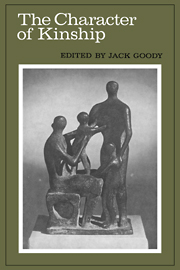Book contents
- Frontmatter
- Contents
- Dedication
- Introduction
- KINSHIP AND DESCENT
- THE NATURE OF KINSHIP
- THE NATURE OF THE FAMILY
- MARRIAGE AND AFFINAL ROLES
- Some Aspects of Levirate
- Polygyny, Economy and the Role of Women
- From Varna to Caste through Mixed Unions
- Bibliography of the Writings of Meyer Fortes
- References
- Index
Some Aspects of Levirate
Published online by Cambridge University Press: 07 May 2010
- Frontmatter
- Contents
- Dedication
- Introduction
- KINSHIP AND DESCENT
- THE NATURE OF KINSHIP
- THE NATURE OF THE FAMILY
- MARRIAGE AND AFFINAL ROLES
- Some Aspects of Levirate
- Polygyny, Economy and the Role of Women
- From Varna to Caste through Mixed Unions
- Bibliography of the Writings of Meyer Fortes
- References
- Index
Summary
‘Siblingship does not cancel out the uniqueness of the individual’
(Fortes, 1949 a p. 243).The levirate has long been a popular ingredient in the anthropological stockpot of exotic kinship institutions. For Frazer and others it provided evidence of ancient forms of group marriage which they, paradoxically, did not live long enough to see, and for some its main interest lay, apparently, in the discovery of Old Testament custom in the more remote parts of the modern world. Others, more recently, have noted how the institution illustrates such diverse features of kinship systems as the equivalence of siblings, the non-equivalence of genitor and pater, and the interconnectedness of forms of marriage and descent rules.
As with many such anthropological chestnuts, however, the move beyond description and ad hoc illustration to more systematic analysis and comparison has proved rather difficult. Thus Gluckman, who has made some of the most significant contributions to our understanding of the institution, has described how he suspended full-scale study of it when he discovered ‘how unclear were reports on whether a widow remained married under the true levirate to her dead husband, or was married by his kinsman in a new marital union’. Here, of course, Gluckman is referring to the now well-known distinction between ordinary widow-inheritance and ‘true’ levirate, which Evans-Pritchard, Radcliffe-Brown and he himself have forcefully drawn, and he has in mind the failure of many writers to clarify such matters as whether in a particular society the dead husband or his kinsman living with his widow is counted as the father of the children whom she subsequently bears.
- Type
- Chapter
- Information
- The Character of Kinship , pp. 163 - 174Publisher: Cambridge University PressPrint publication year: 1974
- 1
- Cited by



